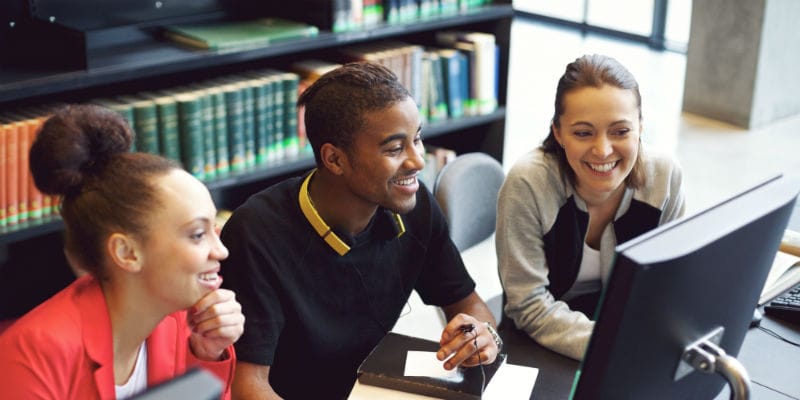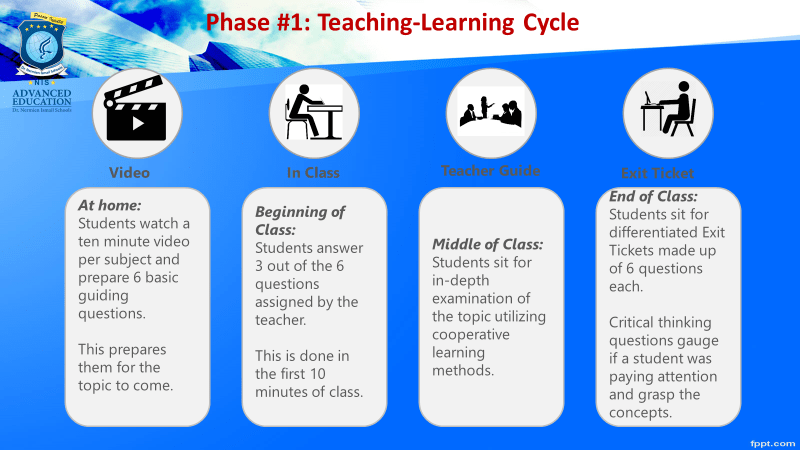Students harness the skill of preparedness through blended learning
April 16, 2019 |
April 16, 2019 |
 In our school, numerous educators have long practiced cooperative learning pedagogical methods. But we’ve recognized that blended learning is another effective mediator to help support student learning in a rapidly changing world.
In our school, numerous educators have long practiced cooperative learning pedagogical methods. But we’ve recognized that blended learning is another effective mediator to help support student learning in a rapidly changing world.
For instance, one benefit to students of a blended-learning approach has been the driver of our school’s work: preparedness. It is the skill of planning ahead for your learning, and being aware of the inquiries you will be expected to know and engage with in the future.”
At Advanced Education Schools, a private, international school located in Cairo, Egypt, we launched a pilot in 2016 of the Flipped Classroom method in a single 9th grade classroom, and have since developed a whole-school policy and protocol for implementation of the Flipped Classroom.
Today, Heads of Departments, Academic Deans, and Principal Offices closely supervise teachers’ implementation of the Flipped Classroom, which looks like this:

For homework, students screen 5-10 minutes of a tailored, pre-recorded green screen/glass screen instructional video, featuring their very own teachers, on the upcoming week’s topic. The teachers ask students to prepare six guiding questions. These questions are tiered to Bloom’s Taxonomy’s 1st tier, recalling.
During classtime, students work collaboratively with peers on an in-depth study of the topic, with the teacher available to guide and support. At the end of the class, students take differentiated exit tickets which prompt students to think critically about the topic they’ve been exploring.
In this model, when students arrive to class at the start of the week, they are aware of exactly what they will be studying, they come prepared with a basic understanding of the topic, and they are ready to dive right in. Students thus have a new sense of ownership over their learning.
Even prior to the blended-learning pilot, Advanced Education had already built an impressive library of in-house tailored videos. These videos are vital to the success of the Flipped Classroom-Exit Ticket process as they tackle skills and content aligned to what students work on with peers and teachers in class.
Starting with the blended-learning pilot phase for the 9th grade English course in 2016, our team monitored student achievement data for two consecutive quarters to compare data both before and after the consistent and regulated use of Flipped Classroom.
The data yielded a positive gain in student progress on both the summative and formative levels. While some variances were incremental, others yielded improvements of up to 30% on both summative and formative assessments. Thirty percent!
Gains in the 10%-30% brackets [up to three letter grades] were mostly found in students who ranked at the below-average level [below 60%].
In addition, failure numbers went down that year, from 20 students to 16 students and continued to fall, despite the fact that the curriculum was becoming increasingly more difficult. Out of 20 failing students in the first quarter, only 5 failed the year and needed make-up exams.
In the third quarter of that academic year, the pilot administrator and I presented the data to our school’s top management, and thereafter to middle school and high school staff. The academic staff became oriented with the process through in-depth professional development and training. This culminated in their readiness to expand the process in the fourth quarter of that year to encompass core subject areas in grades 3 through 12.
Our staff and school leaders didn’t just monitor the comparative trends of data results since initial implementation three years ago; we’ve also monitored trends in student language and behavior. We’ve observed a subtle shift in the language spoken by the overwhelming majority of the student body.
Students went from asking questions like, “What are we going to do, today?” to more thoughtful inquiries like, “Next week we’re going to be covering Romanticism, should I just focus on Emerson or is there anything else I need to study?” The pedagogical shift we’ve made is gradually helping bring about a mindset shift in our next generation of learners.
Through the successful implementation of blended-learning methods, we’ve found that students can be better prepared to learn tomorrow; which, by default, makes them more aware of what they’re learning today.
Amira Awaad is the High School Academic Dean at Advanced Education Schools.
May 02, 2019 at 3:05 am, Jannette said:
Getting to know each students and their needs would be great. Building Relationships.
May 12, 2019 at 5:53 pm, Allyson Pulsipher said:
Flip Learning seems to be a good idea. However, with young students who need the help of their parent at home this could be a challenge to get all parents on board.
May 24, 2019 at 5:06 am, Ethan Willamstead said:
Great article! Circulating to my coworkers. I agree with Awaad, there is something to be said about being prepared as a mindset and blended learning is a highly effective way to make that happen.